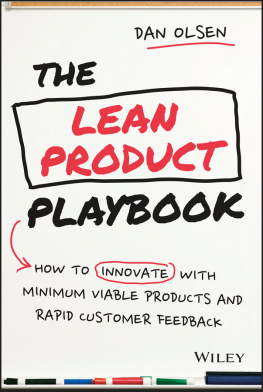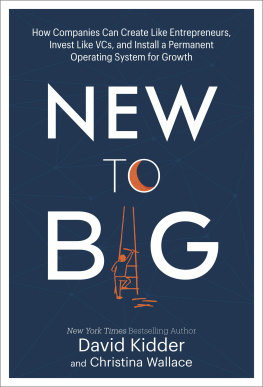The Science of Growth
How Facebook Beat Friendsterand How Nine Other Startups Left the Rest in the Dust
Sean Ammirati

St. Martins Press
New York
Thank you for buying this St. Martins Press ebook.
To receive special offers, bonus content, and info on new releases and other great reads, sign up for our newsletters.

Or visit us online at us.macmillan.com/newslettersignup
For email updates on the author, click here.
The author and publisher have provided this e-book to you for your personal use only. You may not make this e-book publicly available in any way. Copyright infringement is against the law. If you believe the copy of this e-book you are reading infringes on the authors copyright, please notify the publisher at: us.macmillanusa.com/piracy .
Richard Florida
Its a commonplace to say that we inhabit a new economy. But we do. The key to the old one was captured in Charles Wilsons oft-quoted phrase, Whats good for General Motors is good for the country (which, like so many other benchmark sayings, was misquotedwhat he really said was for years I thought what was good for our country was good for General Motors, and vice versa). Still, the gist of it was telling. The United States economy revolved around giant, vertically integrated companies like GM and Ford, IBM and General Electric, US Steel and Proctor & Gamble. They powered the economy and their hundreds of thousands of employees spent the whole of their adult lives working for them. Cities measured their strength by how many of such companies headquarters and manufacturing plants they had. Nobody ever even mentioned startup companies or the talent that drives them. You didnt have to scale anything, because the companies that mattered had such massive scale already.
The past several decades changed all that. Globalization hit hard at many once-great companies and deindustrialization decimated many of the great cities that housed them.
The driving force in our economy has shifted from those behemoths to smaller entrepreneurial startupsand even more importantly, to clusters of fast, nimble technology startups in places like Silicon Valley. Where the old economy was stable and centered, the new economy is more dynamic and volatile. In just the past decade or so, startups have been shifting away from the suburban nerdistans where they were traditionally incubated and toward the urban areas that the creative class has rediscovered and wants and needs to be. Downtown San Francisco now receives more venture capital than Silicon Valley proper; New York City attracts more venture capital than Boston and its surrounding Route 128 suburbs. Cities have the diversity of talent and industry, the density and interactive streetscapes, the openness to new ideas, and the fast-paced metabolisms that enable innovation and innovative enterprises to flourish.
As an urbanist, Ive tried to codify a set of rules and best practices that city leaders and stakeholders can use to create quality, sustainable growth, based upon the simple notion that it is cities and the talent they attract that hold the key to prosperity. If a city is a place that can attract and retain talented, innovative people, innovative businesses will follow.
As a serial entrepreneur, a venture capitalist, and above all, a serious thinker, Sean Ammirati has been doing much the same thing for entrepreneurship and business startups. Ive known him for a long time; the two of us first crossed paths when I was still a professor at Carnegie Mellon in Pittsburgh and when I was in the early stages of writing Rise of the Creative Class.
In The Science of Growth, he peers into the black box of successful startups, posing and answering the all-important question: What makes some startups scale quickly and others fail to take off at all? To get at it, he examines ten paired sets of companies to separate the winners and losers and identify what drives successFacebook and Friendster in social media, for example, and McDonalds and White Castle in fast foodplus six other successful startups that were more or less unique, like Twitter, Airbnb, and Google.
What makes the difference? The answers Ammirati provides are powerful and complex. A key factor he zeros in on is the ability of companies to achieve escape velocity. To my great delight and fascination, he shows that this is not an abstract construct but is a direct product of people and the places they inhabit. Successful startups reflect the passion and vision of the entrepreneurs who dream them up and bring them into the world, and the skills and technological prowess of the people who work for them.
At the same time, those entrepreneurs and their companies are products of the communities that they are embedded in, even as they in turn shape those places long-term futures. High-growth entrepreneurship is critical for a regions long-term health, Ammirati rightly points out, new job growth is driven not by large corporations but by high-growth startups. When startups successfully scale, the places in which they are located often scale too. As more and more startups take root, a virtuous cycle sets in as other talented people and innovative companies are drawn to the city, generating more investment capital and improving its quality of place still more.
In The Science of Growth, Ammirati provides an essential playbook for the entrepreneurs and venture capitalists who are investing in and shaping the next round of disruptive, high-growth enterprisesand who are helping to power the future of our cities and of our economy as a whole.
Richard Florida, author of the best-selling The Rise of the Creative Class , is the Director of the Martin Prosperity Institute at the University of Torontos Rotman School of Management, Global Research Professor at NYU, and co-founder and editor-at-large of The Atlantic s CityLab.
Genius is one percent inspiration and ninety-nine percent perspiration.
Thomas Edison
If someone awoke after a fifty-year slumber, theyd find the new world to be a magical place. The phones in our pockets can call anyone in the world, yet we rarely speak into them. Instead, they are fully functioning computers with apps that can make a car or meal show up magically without our having to utter a word. If the modern-day Rip Van Winkle were to open the paper (likely on a tablet), they could read about multiple companies trying to build self-driving cars. Of course, prior generations could point to advances in their lifetimes that were similarly transformative, including the mass adoption of automobiles, televisions, radios, telephones, and even electricity.
Its because of passionate entrepreneurs that each of these improvements exists. Entrepreneurs see things that are broken in our everyday lives, and create the world they think we ought to live in by commercializing innovation.
I think the future is very bright, because more and more people are contemplating entrepreneurship as a career. From 1990 until today, the number of entrepreneurship programs on college campuses has increased from 180 to over 2,000.
And these emerging entrepreneurs have more and more high-quality material available to them, both in the classroom and on their nightstands. Thanks to thought leaders like Eric Reis and Steve Blank, the lean startup movement has captivated Silicon Valley and entrepreneurs across the country.
If you arent familiar with the lean startup movement, its a philosophy that basically takes the scientific method and applies it to the process of building a company. You devise a set of experiments, as efficiently as possible, to validate or invalidate key hypotheses about your business. The term lean comes from some of the techniques this process leverages from lean manufacturing.







